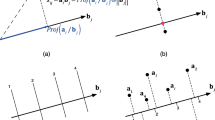Abstract
Empirical-likelihood-based inference for parameters defined by the general estimating equations of Qin and Lawless (1994) remains an active research topic. When the response is missing at random (MAR) and the dimension of covariate is not low, the authors propose a two-stage estimation procedure by using the dimension-reduced kernel estimators in conjunction with an unbiased estimating function based on augmented inverse probability weighting and multiple imputation (AIPW-MI) methods. The authors show that the resulting estimator achieves consistency and asymptotic normality. In addition, the corresponding empirical likelihood ratio statistics asymptotically follow central chi-square distributions when evaluated at the true parameter. The finite-sample performance of the proposed estimator is studied through simulation, and an application to HIV-CD4 data set is also presented.
Similar content being viewed by others
References
Hansen L P, Large sample properties of generalized method of moments estimators, Econometrica, 1982, 50: 1029–1054.
Liang K Y and Zeger S L, Longitudinal data analysis using generalized linear models, Biometrika, 1986, 73: 13–22.
Imbens G W, Generalized method of moments and empirical likelihood, Journal of Business and Economic Statistics, 2002, 20: 493–506.
Bravo F, Empirical likelihood based inference with applications to some econometric models, Econometric Theory, 2004, 20: 231–264.
Owen A B, Empirical likelihood ratio confidence intervals for a single functional, Biometrika, 1988, 75: 237–249.
Owen A B, Empirical likelihood ratio confidence regions, The Annals of Statistics, 1990, 18: 90–120.
Qin J and Lawless J, Empirical Likelihood and general estimating equations, The Annals of Statistics, 1994, 22: 300–325.
Cheng P E, Nonparametric estimation of mean functionals with data missing at random, Journal of the American Statistical Association, 1994, 89: 81–87.
Ibrahim J G, Chen M H, Lipsitz S R, and et al., Missing-data methods for generalized linear models: A comparative review, Journal of the American Statistical Association, 2005, 100: 332–346.
Wooldridge J M, Inverse probability weighted estimation for general missing data problems, Journal of Econometrics, 2007, 141: 1281–1301.
Shao J and Wang L, Semiparametric inverse propensity weighting for nonignorable missing data, Biometrika, 2016, 103: 175–187.
Zhou Y, Wan A T K, and Wang X, Estimating equation inference with missing data, Journal of the American Statistical Association, 2008, 103: 1187–1199.
Wang D and Chen S X, Empirical likelihood for estimating equations with missing values, The Annals of Statistics, 2009, 37: 490–517.
Wang L, Rotnitzky A, and Lin X, Nonparametric regression with missing outcomes using weighted kernel estimating equations, Journal of the American Statistical Association, 2010, 105: 1135–1146.
Tang C Y and Qin Y, An efficient empirical likelihood approach for estimating equations with missing data, Biometrika, 2012, 99: 1001–1007.
Chen X, Wan A T, and Zhou Y, Efficient quantile regression analysis with missing observations, Journal of the American Statistical Association, 2015, 110: 723–741.
Ding X and Wang Q, Fusion-refinement procedure for dimension reduction with missing response at random, Journal of the American Statistical Association, 2011, 106: 1193–1207.
Hu Z, Follmann D A, and Wang N, Estimation of mean response via effective balancing score, Biometrika, 2014, 101: 613–624.
Li Y, Wang Q, Zhu L, et al., Mean response estimation with missing response in the presence of high-dimensional covariates, Communications in Statistics — Theory and Methods, 2017, 46: 628–643.
Dong Y, Xia Q, Tang C Y, et al., On sufficient dimension reduction with missing responses through estimating equations, Computational Statistics and Data Analysis, 2018, 126: 67–77.
Cook R D and Weisberg S, Discussion of “sliced inverse regression for dimension reduction”, Journal of the American Statistical Association, 1991, 86: 28–33.
Li K C, Sliced inverse regression for dimension reduction, Journal of the American Statistical Association, 1991, 86: 316–327.
Cook R D, On the interpretation of regression plots, Journal of the American Statistical Association, 1994, 89: 177–189.
Xia Y, Tong H, Li W K, et al., An adaptive estimation of dimension reduction space, Journal of the Royal Statistical Society: Series B, 2002, 64: 363–410.
Ma Y and Zhu L, A semiparametric approach to dimension reduction, Journal of the American Statistical Association, 2012, 107: 168–179.
Ma Y and Zhu L, A review on dimension reduction, International Statistical Review, 2013, 81: 134–150.
Zhu L P, Zhu L X, Ferre L, et al., Sufficient dimension reduction through discretization-expectation estimation, Biometrika, 2010, 97: 295–304.
Hammer S M, Katzenstein D A, Hughes M D, et al., A trial comparing nucleoside monotherapy with combination therapy in HIV-infected adults with CD4 cell counts from 200 to 500 per cubic millimeter, The New England Journal of Medicine, 1996, 335: 1081–1089.
Andrews D W, Nonparametric kernel estimation for semiparametric models, Econometric Theory, 1995, 11: 560–586.
Author information
Authors and Affiliations
Corresponding author
Additional information
This paper was supported by the National Natural Science Foundation of China under Grant Nos. 11871287, 11501208, 11771144, 11801359, the Natural Science Foundation of Tianjin under Grant No. 18JCYBJC41100, Fundamental Research Funds for the Central Universities and the Key Laboratory for Medical Data Analysis and Statistical Research of Tianjin. The first two authors contributed equally to this work.
This paper was recommended for publication by Editor SHAO Jun.
Rights and permissions
About this article
Cite this article
Wang, L., Sun, S. & Xia, Z. An Efficient Multiple Imputation Approach for Estimating Equations with Response Missing at Random and High-Dimensional Covariates. J Syst Sci Complex 34, 440–464 (2021). https://doi.org/10.1007/s11424-020-9133-9
Received:
Revised:
Published:
Issue Date:
DOI: https://doi.org/10.1007/s11424-020-9133-9




